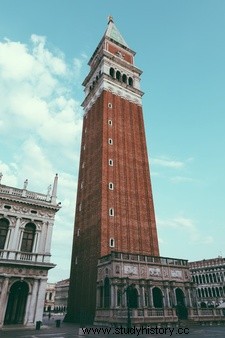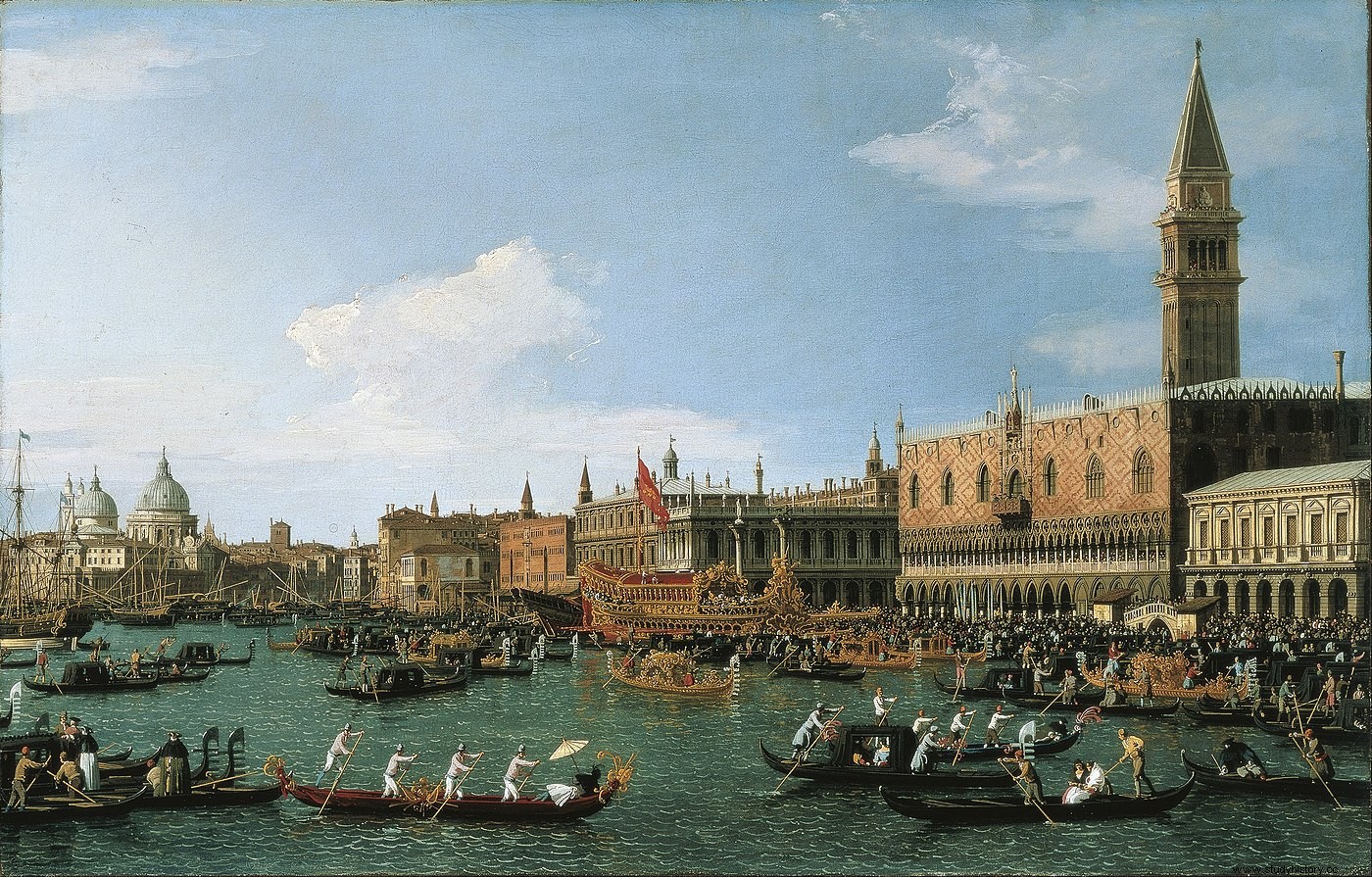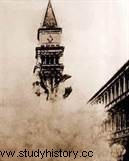 At the heart of the Serenissima, the campanile of Saint Mark is a symbol . It is in Piazza San Marco that the highest campanile of the city of Venice is located, which culminates at nearly ninety-eight meters in height. A square or round bell tower, generally pierced by arcades on several levels, the campaniles were most often built as an element in their own right, not forming part of the church or the cathedral. They housed the bells that were used to call the faithful to prayer. During the Renaissance, the bell tower became the object of rivalry between Italian cities and its construction was often entrusted to great artists.
At the heart of the Serenissima, the campanile of Saint Mark is a symbol . It is in Piazza San Marco that the highest campanile of the city of Venice is located, which culminates at nearly ninety-eight meters in height. A square or round bell tower, generally pierced by arcades on several levels, the campaniles were most often built as an element in their own right, not forming part of the church or the cathedral. They housed the bells that were used to call the faithful to prayer. During the Renaissance, the bell tower became the object of rivalry between Italian cities and its construction was often entrusted to great artists.
The construction of the first bell tower in Venice (9th – 19th century)
Pietro Tribuno, seventeenth Doge of the Serenissima Republic of Venice, launched in 888 the construction of the bell tower of Saint-Marc. The erection of the building was completed under the dogat of Domenico Morosini, in the 12th century. But the construction of this "first campanile" was not easy:indeed, in 1080 , while the tower was being built, the ground literally gave way under its weight, and everything had to be started from the beginning. Silvio Domenico, then doge of Venice, ordered the demolition of what remained of the building, and decided to rebuild it a few fathoms away, still in Piazza San Marco.
 The Fire of 1489 , which ravaged much of the sestiere of San Marco, seriously damaged the campanile. The wooden arrow that had been placed in 1178 at the tip of the building was destroyed; this shows the full extent of the disaster that struck the tower. This "first campanile", inspired by that of Forli, in Emilia-Romagna, had a difficult start:in 1511 , an earthquake once again weakened the building, which eventually collapsed. From then on, it was decided to launch a large undertaking of works, aimed at rebuilding a new, reinforced tower:Giorgio Spavento and Bartolomeo Bon, architects, added a marble bell tower to the campanile, on which a sculpture of the lion of Saint Mark was enthroned, as well as a golden angel, hoisted at the tip of the tower in 1513 .
The Fire of 1489 , which ravaged much of the sestiere of San Marco, seriously damaged the campanile. The wooden arrow that had been placed in 1178 at the tip of the building was destroyed; this shows the full extent of the disaster that struck the tower. This "first campanile", inspired by that of Forli, in Emilia-Romagna, had a difficult start:in 1511 , an earthquake once again weakened the building, which eventually collapsed. From then on, it was decided to launch a large undertaking of works, aimed at rebuilding a new, reinforced tower:Giorgio Spavento and Bartolomeo Bon, architects, added a marble bell tower to the campanile, on which a sculpture of the lion of Saint Mark was enthroned, as well as a golden angel, hoisted at the tip of the tower in 1513 .
Over the centuries, multiple fires weakened the bell tower:April 13, 1745 , a disaster caused cracks in the masonry, and caused major rockfalls that killed several Venetians. This "primitive campanile" of Venice, in fact, took almost a millennium to be developed and built. Various and successive disasters greatly weakened the building, which was never truly completed.
The collapse of 1902

“Com’era, dov’era “, “as he was, where he was”. These were the words of the Municipal Council of Venice, which decided on the very evening of the disaster to rebuild the Campanile of San Marco. At the beginning of the year 1903 , the first stone of the construction was laid; the campanile was rebuilt with the materials of the first. The whole of Europe was moved by this tragedy, and donations flowed to Venice. April 25, 1912 – ten days after the sinking of the Titanic… - the new campanile was inaugurated on the feast day of Saint Mark. In fact, it was not the first time that the bell tower of Saint-Marc had collapsed. Indeed, it has collapsed five times in history:in 1080 , in 1388 , in 1489 , in 1511 , and therefore in 1902 .
The Campanile of Saint Mark, a symbol of immortality
St. Mark's Campanile, like its older "version", houses five bells. The “Marangana », ringing morning and evening, announces the beginning and the end of work; he "Maleficia announced death sentences; the “Nana 9 th sounded hour; the “Trattiera called on the magistrates to go to the sessions of the Doge's Palace; finally, the bell of the "Pregadi », which called on the senators to go to the ducal palace. It is therefore easier to understand the attachment that the Venetians had and have for the bell tower, symbol of the city, which has always truly punctuated their daily life.
Venice, an age-old city, totally out of time, seems immortal. All you have to do is take a walk in the Serenissima in the evening to realize this. The Venetians are very attached to their campanile, since it is truly the emblem of the city. Often destroyed, always rebuilt, the bell tower of Saint-Marc is the symbol of the immortality of the Serenissima. It is not for nothing that the Venetians have always nicknamed him the "master of the house .
To go further
- Venice seen from its Campaniles by T. Sammartini. 2003.
- Venice:Art and Architecture by Marion Kaminski. 2006.
